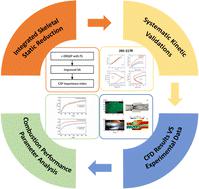Our official English website, www.x-mol.net, welcomes your feedback! (Note: you will need to create a separate account there.)
Application of static integrated skeletal reduction and tabulation of dynamic adaptive chemistry in the combustion simulation of ethylene-fueled scramjet combustor
RSC Advances ( IF 3.9 ) Pub Date : 2024-05-08 , DOI: 10.1039/d4ra00749b Zhongwen Li 1, 2 , Jianwen Liu 3 , Jingbo Wang 1, 2
RSC Advances ( IF 3.9 ) Pub Date : 2024-05-08 , DOI: 10.1039/d4ra00749b Zhongwen Li 1, 2 , Jianwen Liu 3 , Jingbo Wang 1, 2
Affiliation

|
The high-fidelity reduced mechanism is one of the key elements in the combustion simulation of scramjet combustors to reveal their combustion and flow phenomena. In the present work, the hierarchically constructed NUIGMech1.2 (2857 species and 11 814 reactions) is applied to the combustion simulation of an ethylene-fueled scramjet combustor using the method of static integrated skeletal reduction and tabulation of dynamic adaptive chemistry (TDAC). The integrated skeletal reduction strategy successively consists of species elimination using the revised directed relation graph with error propagation method of fixed species scheme and improved sensitivity analysis method, and reactions elimination based on computational singular perturbation importance index. A preferred ethylene skeletal mechanism (26 species and 117 reactions) is obtained through the integrated skeletal reduction strategy under target working conditions of temperature range of 900–1800 K, pressure range of 1–4 atm, and equivalence ratio range of 0.25–5.0. The compact skeletal mechanism is comprehensively validated against the experimental results of ignition delay times, laminar flame speeds, and key species concentration profiles. Meanwhile, it shows consistent results with the detailed mechanism on the adiabatic flame temperature profiles and “S”-curves. When applying this skeletal mechanism to combustion simulations of ethylene-fueled scramjet combustor with double parallel cavities, the path flux analysis method and in situ adaptive tabulation algorithm of TDAC is further utilized to speed up the chemical reaction solution process at run-time. Under the scramjet and ramjet modes, the corresponding simulation results in terms of flame luminosity images, schlieren images, and static pressure distributions, coincide well with those of experimental measurements. The combustion and flow characteristics of the two modes are investigated and analyzed comparatively based on above results and combustion performance parameters. Present work contributes to the application of fuel kinetic mechanisms in scramjet combustor combustion simulation.
中文翻译:

静态集成骨架还原与动态自适应化学制表在乙烯燃料超燃冲压发动机燃烧模拟中的应用
高保真简化机构是超燃冲压发动机燃烧室燃烧模拟中揭示其燃烧和流动现象的关键要素之一。在目前的工作中,分层构建的 NUIGMech1.2(2857 个物种和 11 814 个反应)采用静态集成骨架还原和动态自适应化学列表(TDAC)方法应用于乙烯燃料超燃冲压发动机燃烧室的燃烧模拟。综合骨架约简策略依次包括利用固定物种方案的误差传播方法和改进的敏感性分析方法修正有向关系图的物种消除和基于计算奇异扰动重要性指数的反应消除。在温度范围为900-1800 K、压力范围为1-4 atm、当量比范围为0.25-5.0的目标工况下,通过集成骨架还原策略获得了优选的乙烯骨架机理(26种和117个反应)。紧凑的骨架机制根据点火延迟时间、层流火焰速度和关键物质浓度分布的实验结果进行了全面验证。同时,它在绝热火焰温度分布和“S”曲线上显示出与详细机制一致的结果。当将该骨架机构应用于双平行腔乙烯超燃冲压发动机燃烧模拟时,进一步利用TDAC的路径通量分析方法和原位自适应制表算法来加速运行时的化学反应求解过程。在超燃冲压发动机和冲压发动机模式下,相应的火焰光度图像、纹影图像和静压分布的模拟结果与实验测量结果吻合较好。根据上述结果和燃烧性能参数,对两种工况的燃烧和流动特性进行了研究和比较分析。目前的工作有助于燃料动力学机制在超燃冲压发动机燃烧室燃烧模拟中的应用。
更新日期:2024-05-08
中文翻译:

静态集成骨架还原与动态自适应化学制表在乙烯燃料超燃冲压发动机燃烧模拟中的应用
高保真简化机构是超燃冲压发动机燃烧室燃烧模拟中揭示其燃烧和流动现象的关键要素之一。在目前的工作中,分层构建的 NUIGMech1.2(2857 个物种和 11 814 个反应)采用静态集成骨架还原和动态自适应化学列表(TDAC)方法应用于乙烯燃料超燃冲压发动机燃烧室的燃烧模拟。综合骨架约简策略依次包括利用固定物种方案的误差传播方法和改进的敏感性分析方法修正有向关系图的物种消除和基于计算奇异扰动重要性指数的反应消除。在温度范围为900-1800 K、压力范围为1-4 atm、当量比范围为0.25-5.0的目标工况下,通过集成骨架还原策略获得了优选的乙烯骨架机理(26种和117个反应)。紧凑的骨架机制根据点火延迟时间、层流火焰速度和关键物质浓度分布的实验结果进行了全面验证。同时,它在绝热火焰温度分布和“S”曲线上显示出与详细机制一致的结果。当将该骨架机构应用于双平行腔乙烯超燃冲压发动机燃烧模拟时,进一步利用TDAC的路径通量分析方法和原位自适应制表算法来加速运行时的化学反应求解过程。在超燃冲压发动机和冲压发动机模式下,相应的火焰光度图像、纹影图像和静压分布的模拟结果与实验测量结果吻合较好。根据上述结果和燃烧性能参数,对两种工况的燃烧和流动特性进行了研究和比较分析。目前的工作有助于燃料动力学机制在超燃冲压发动机燃烧室燃烧模拟中的应用。






























 京公网安备 11010802027423号
京公网安备 11010802027423号